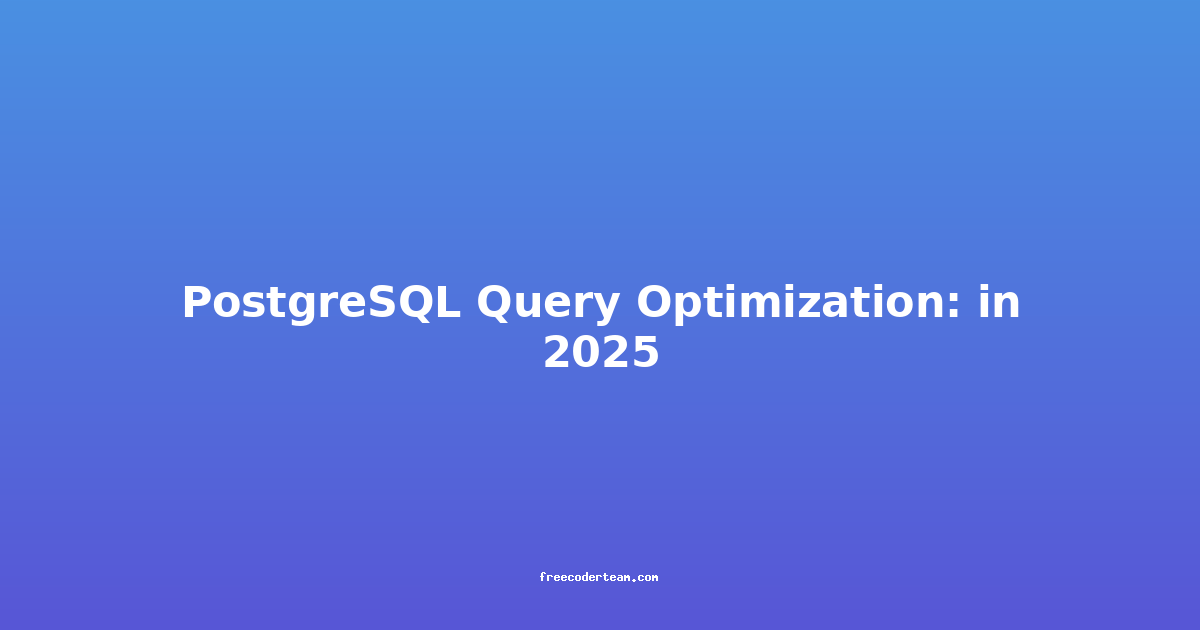PostgreSQL Query Optimization in 2025: Best Practices and Advanced Techniques
PostgreSQL, a powerful open-source relational database system, continues to evolve as one of the most robust and feature-rich databases available. As we approach the year 2025, optimizing PostgreSQL queries remains a critical aspect of maintaining high performance, scalability, and efficiency in data-driven applications. In this blog post, we'll explore advanced techniques, best practices, and actionable insights for query optimization in PostgreSQL, ensuring your applications can handle the demands of modern workloads.
Table of Contents
- Understanding Query Optimization
- Best Practices for Query Optimization
- Practical Examples
- Future Trends and Tools
- Conclusion
Understanding Query Optimization
Query optimization is the process of refining SQL queries to improve their performance without altering their results. In PostgreSQL, this involves identifying bottlenecks, analyzing query execution plans, and applying techniques to reduce resource usage and improve response times. As applications grow in complexity and data volumes increase, query optimization becomes essential to ensure smooth operation.
Modern applications often require real-time analytics, complex joins, and large-scale data processing. PostgreSQL provides a rich set of tools and features to help developers and database administrators optimize queries effectively. By leveraging these tools, you can ensure that your database remains responsive and scalable.
Best Practices for Query Optimization
1. Indexing Strategies
Indexing is one of the most effective ways to speed up data retrieval in PostgreSQL. By creating indexes on frequently queried columns, you can significantly reduce the time it takes to locate data. However, improper indexing can lead to unnecessary overhead, so it's crucial to use them judiciously.
Types of Indexes
- B-Tree Index: The most common type of index, suitable for equality and range queries.
- Gin Index: Ideal for full-text search and JSONB data types.
- Gist Index: Useful for spatial and range queries.
- Hash Index: Suitable for equality queries but not for range queries.
Best Practices
- Index Only Scans: Ensure that all columns used in a query are included in the index to avoid additional table lookups.
- Partial Indexes: Create indexes only on a subset of data to reduce index size and maintenance overhead.
- Composite Indexes: Combine multiple columns in a single index to optimize queries involving multiple conditions.
-- Example: Creating a B-Tree index on a column
CREATE INDEX idx_user_email ON users(email);
-- Example: Composite index for a query with multiple conditions
CREATE INDEX idx_user_name_email ON users(first_name, last_name, email);
2. Analyzing Query Performance
To optimize queries effectively, you must first understand their performance characteristics. PostgreSQL provides several tools to analyze query execution plans, identify bottlenecks, and measure performance.
Tools for Query Analysis
- EXPLAIN: Analyzes the query execution plan without executing the query.
- EXPLAIN ANALYZE: Executes the query and provides detailed performance metrics.
- pg_stat_statements: A built-in extension that tracks query performance metrics.
Using EXPLAIN ANALYZE
EXPLAIN ANALYZE
SELECT *
FROM users
WHERE email = 'john.doe@example.com';
This command will show the execution plan, including time spent on each operation, such as sequential scans, index scans, and joins.
3. Using Appropriate Data Types
Choosing the right data types can have a significant impact on query performance. PostgreSQL offers a wide range of data types, each optimized for specific use cases. For example, using integer instead of numeric for simple arithmetic operations can improve performance.
Best Practices
- Use Smaller Data Types: For example,
smallintinstead ofbigintwhen possible. - Avoid
textfor Large Data: Usevarchar(n)orchar(n)when the size of the data is predictable. - Index Compression: Use
ginorgistindexes for compressed data types likejsonborhstore.
-- Example: Using `integer` instead of `bigint`
ALTER TABLE transactions
ALTER COLUMN amount TYPE integer USING amount::integer;
4. Query Rewriting and Refactoring
Sometimes, the structure of a query can be a significant bottleneck. Refactoring queries to use more efficient operations can lead to substantial performance improvements.
Techniques
- Avoid Using
SELECT *: Only select the columns you need to reduce the amount of data fetched. - Use JOINs Instead of Subqueries: JOINs are often more efficient, especially when dealing with large datasets.
- Materialized Views: Cache the results of complex queries for faster retrieval.
-- Example: Refactoring a query to avoid subqueries
-- Before
SELECT *
FROM users
WHERE id IN (SELECT user_id FROM orders WHERE order_status = 'completed');
-- After
SELECT u.*
FROM users u
JOIN orders o ON u.id = o.user_id
WHERE o.order_status = 'completed';
5. Partitioning Large Tables
Partitioning is a powerful technique for breaking large tables into smaller, more manageable segments. This can dramatically improve query performance, especially for queries that filter data based on a partition key.
Types of Partitioning
- Range Partitioning: Divides data based on a range of values (e.g., dates).
- List Partitioning: Divides data based on specific values.
- Hash Partitioning: Distributes data based on a hash function.
Example: Range Partitioning
-- Create a parent table
CREATE TABLE orders (
order_id bigint PRIMARY KEY,
order_date date,
customer_id integer,
total_amount numeric
);
-- Create partitions
CREATE TABLE orders_2025 PARTITION OF orders
FOR VALUES FROM ('2025-01-01') TO ('2026-01-01');
CREATE TABLE orders_2026 PARTITION OF orders
FOR VALUES FROM ('2026-01-01') TO ('2027-01-01');
6. Leveraging Prepared Statements
Prepared statements are precompiled SQL queries that can be executed multiple times with different parameter values. This reduces parsing and planning overhead, making them ideal for frequent, similar queries.
Example: Using Prepared Statements
-- Prepare a statement
PREPARE get_user_details(int) AS
SELECT * FROM users WHERE id = $1;
-- Execute the prepared statement
EXECUTE get_user_details(123);
-- Deallocate the prepared statement
DEALLOCATE get_user_details;
Practical Examples
Example 1: Optimizing a Slow Query
Problem
You have a slow query that retrieves all users with a specific email domain.
SELECT *
FROM users
WHERE email LIKE '%@example.com';
Solution
- Indexing: Create an index on the
emailcolumn. - Query Refactoring: Use a more efficient pattern matching.
-- Create an index
CREATE INDEX idx_email_domain ON users(email);
-- Rewrite the query
SELECT *
FROM users
WHERE email LIKE '%@example.com';
Alternatively, you can use a more precise index by storing the domain in a separate column.
-- Add a domain column
ALTER TABLE users ADD COLUMN email_domain text;
-- Update the domain column
UPDATE users
SET email_domain = split_part(email, '@', 2);
-- Create an index on the domain
CREATE INDEX idx_email_domain ON users(email_domain);
-- Rewrite the query
SELECT *
FROM users
WHERE email_domain = 'example.com';
Example 2: Partitioning a Large Table
Problem
You have a large orders table with millions of rows, and queries filtering by order_date are slow.
Solution
Partition the orders table by year to improve query performance.
-- Create a parent table
CREATE TABLE orders (
order_id bigint PRIMARY KEY,
order_date date,
customer_id integer,
total_amount numeric
) PARTITION BY RANGE (order_date);
-- Create partitions
CREATE TABLE orders_2025 PARTITION OF orders
FOR VALUES FROM ('2025-01-01') TO ('2026-01-01');
CREATE TABLE orders_2026 PARTITION OF orders
FOR VALUES FROM ('2026-01-01') TO ('2027-01-01');
Now, queries filtering by order_date will only scan the relevant partition, improving performance.
Future Trends and Tools
As we approach 2025, several emerging trends and tools will influence PostgreSQL query optimization:
- Machine Learning for Query Optimization: Tools like pg_repack and pg_sentry are already using AI to suggest index optimizations and query refactorings.
- Serverless PostgreSQL: Platforms like AWS Aurora and Google Cloud SQL offer serverless options that automatically scale and optimize query execution.
- Parallel Query Execution: PostgreSQL 15 and beyond will continue to improve parallel query execution, allowing complex queries to leverage multiple CPU cores.
- Advanced Indexing Techniques: New indexing methods, such as zlib compression for indexes, will reduce storage overhead and improve performance.
Conclusion
PostgreSQL query optimization in 2025 will continue to be a critical skill for database administrators and developers. By leveraging indexing, analyzing query performance, choosing appropriate data types, and leveraging advanced features like partitioning and prepared statements, you can ensure that your PostgreSQL database remains efficient and scalable.
As technology evolves, so will the tools and techniques available for query optimization. Staying informed about these advancements and embracing best practices will help you build robust, high-performing applications that meet the demands of modern data workloads.
Final Tip: Always profile your queries regularly, especially as your application grows. Tools like pg_stat_statements and pgBadger can provide insights into which queries need optimization. Regular maintenance, such as reindexing and statistics updates, is also essential to keep your database running smoothly.




